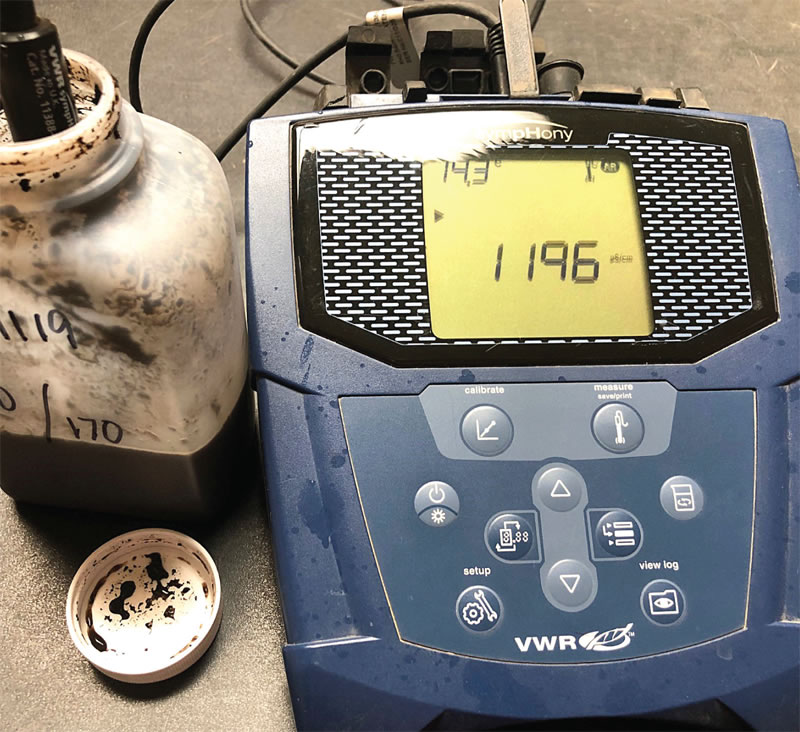Identical samples of two composts were sent to six labs for testing and analysis. Results highlight differences between using the national TMECC standards versus other test methods.
Charles Duprey
BioCycle November/December 2019
In August 2001, many years of work came to fruition with the formal completion of the Test Methods for the Examination of Composting & Compost (TMECC). Nearly 20 years after publication of this document, more than a dozen laboratories formally adhere to the nationwide TMECC standards. As compost use increases, compost manufacturers, architects, engineers, and other users, along with regulators, recognize and accept these testing methods as the basis of understanding of compost composition and appropriate use.
All compost test results and lab analyses, however, are not based on the same standards. The TMECC standards are widely adopted, but are not truly universal. Many laboratories around the country use different standards to evaluate important compost parameters that are critical to soil, plant health and the successful use of compost. These methods are neither right nor wrong; they are simply different methods that can lead to variations in the results.
TMECC Origins
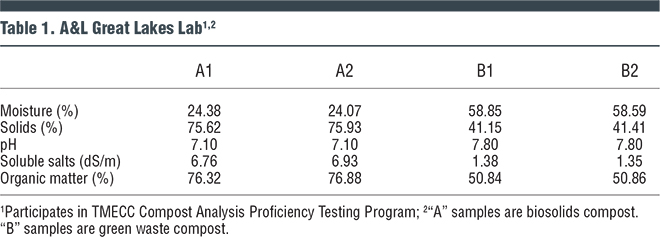
 In 1995, the Proctor & Gamble Company — which had created a $20 million fund to support compost research — and the Composting Council Research & Education Foundation, initiated a joint project to create the TMECC and guide it through a vigorous peer review process. Over the course of many years, well-known scientists and professionals contributed research, ideas and standards to each of nine working groups. These teams worked through an extended United States Department of Agriculture (USDA) review process to independently and scientifically evaluate and eventually produce the document that would become the TMECC.
In 1995, the Proctor & Gamble Company — which had created a $20 million fund to support compost research — and the Composting Council Research & Education Foundation, initiated a joint project to create the TMECC and guide it through a vigorous peer review process. Over the course of many years, well-known scientists and professionals contributed research, ideas and standards to each of nine working groups. These teams worked through an extended United States Department of Agriculture (USDA) review process to independently and scientifically evaluate and eventually produce the document that would become the TMECC.
Development of these universal compost analytical standards culminated in 2001 with their publication by the US Government Publishing Office, thereby making the TMECC an official document of the USDA. The final step of this six-stage process required creation of the Compost Analysis Proficiency (CAP) Testing Program. To this day, the CAP program operates behind the scenes to “provide the compost laboratory analysis industry with an inter-laboratory Quality Analysis/Quality Control program.” It is currently managed by Dr. Robert Miller of Colorado State University and provides the comparative data needed to measure the performance and precision of the TMECC analytical methods. The US Composting Council’s Seal of Testing Assurance Program and Certified Compost emerged from the TMECC standards as an independent analysis of finished compost by participating TMECC labs that are regulated by the CAP Testing Program.

 The CAP concept operates on split blind samples collected by sites nationwide. Samples are sent to Colorado State, where Dr. Miller does the splits and then sends them to the participating laboratories on a regular basis. He evaluates and compares test results on a variety of compost types to confirm adherence to the standards, evaluates needed changes and works with labs to verify a consistent quality of outcomes. As a result, these labs uphold a certain range of acceptable results for important factors like pH, soluble salts and organic matter.
The CAP concept operates on split blind samples collected by sites nationwide. Samples are sent to Colorado State, where Dr. Miller does the splits and then sends them to the participating laboratories on a regular basis. He evaluates and compares test results on a variety of compost types to confirm adherence to the standards, evaluates needed changes and works with labs to verify a consistent quality of outcomes. As a result, these labs uphold a certain range of acceptable results for important factors like pH, soluble salts and organic matter.
Compost is used in many different applications, such as erosion control blankets, a mulch alternative, or blending with soil to improve it. By amending soil with compost, the purpose is to change the soil’s physical, chemical or biological characteristics to better meet its intended use. Examples include adding compost to increase organic matter prior to planting a boxwood tree, using compost to buffer pH before planting turfgrass, or determining an acceptable level of soluble salts for a bioretention application. If one laboratory reports a high level of organic matter in a particular compost, and another lab shows a much lower level in the same compost, what negative effects could result from overuse or underuse of the compost?
The universal aspect of the TMECC standards demonstrates their importance in these cases. In the real world though, many soil and environmental labs do not use the TMECC analytical standards. Some labs may prefer to use a state’s agricultural extension suggested procedure, or qualify results based on local soil conditions versus generally accepted standards.
Comparing Compost Analytical Methods

 This fall (2019), my firm, Naturcycle, undertook a research project to compare critical compost analytical methods between a lab that participates in CAP (and thus uses TMECC standards) and labs that do not. Two composts were selected: a biosolids-based compost and a green waste compost, both from well-operated, permitted facilities. Large composite samples were taken of these composts, from which split samples were sent to A&L Great Lakes Laboratories in Fort Wayne, Indiana and five other labs distributed geographically around the country. None of these five labs participate in the CAP program, although in some cases, they may use a TMECC method. We intentionally selected 5 labs that do not advertise using TMECC Methods, with the assumption that many compost users are not conversant in laboratory testing methodologies.
This fall (2019), my firm, Naturcycle, undertook a research project to compare critical compost analytical methods between a lab that participates in CAP (and thus uses TMECC standards) and labs that do not. Two composts were selected: a biosolids-based compost and a green waste compost, both from well-operated, permitted facilities. Large composite samples were taken of these composts, from which split samples were sent to A&L Great Lakes Laboratories in Fort Wayne, Indiana and five other labs distributed geographically around the country. None of these five labs participate in the CAP program, although in some cases, they may use a TMECC method. We intentionally selected 5 labs that do not advertise using TMECC Methods, with the assumption that many compost users are not conversant in laboratory testing methodologies.
As a basis for comparison, A&L Great Lakes Labs conducted the TMECC analytical methods for organic matter, soluble salts and pH, all important parameters that can determine how much compost should be used, and if the compost is even acceptable for that particular use. Different labs can and do use different analytical methods, conversion factors and approaches. The purpose of our project is to gain a better understanding of potential differences in test results. The data helps explore how these variations could affect compost applications or the determination about whether that compost should be used. The benefit of the TMECC protocol is that it enables an apples-to-apples comparison, which is beneficial to the average compost user.
Comparison Of Results
The test results from A&L Great Lakes Lab, which complies with the TMECC standards, as well as the test results from the five anonymous labs, have been compiled in Tables 1-6. Table 1 reports test results from the A&L lab. Sample A was the biosolids compost, split into two unique samples: A1 and A2. Sample B was the green waste compost, split into two unique samples: B1 and B2. There are clearly varying data as a result of different methodologies used.
Percent Solids And Moisture
It is common for compost analysis to report the percent solids in the compost material as received. Most of the labs showed very similar numerical values for the percent solids and percent moisture for the split identical samples — roughly within 1 to 2 percentage points. Lab #2 (Table 2) failed to report solids and moisture content.
Sample preparation methodology is important to deriving final results. The current TMECC includes detailed sample preparation as part of the standard. Not all labs utilize an air-drying humidity controlled method to dry samples, which can lead to varying results on a few different analyses. For a compost being used specifically for agronomic application of nitrogen, for example, understanding the percent solids is important to calculating the tons per acre needed to apply. Microwave drying can volatilize some forms of nitrogen if a material is dried too rapidly or too much.
pH
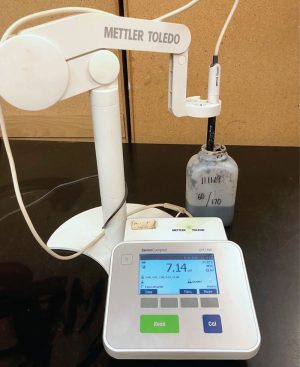
To measure pH, the TMECC method utilized by A&L Great Lakes Lab calls for a 1:5 dilution ratio of compost to water. Photo courtesy of A&L Great Lakes Lab
The pH is a figure expressing the acidity or alkalinity of a solution on a logarithmic scale, where 7 is neutral, lower values are more acidic and higher values are more alkaline. It is a measure of free hydrogen ions in a given material. Variances in pH can often be accounted for in testing methodology. TMECC calls for a 1:5 (1 part compost, 5 parts water) dilution of the material, whereas testing for a saturated media extract is performed at a lower ratio. The amount of water added in the TMECC method is higher than the amount added in other methods, leading to different pH results.
A soil’s pH is a critical characteristic for many plant types, along with the potential for additional fertilizer needs. Many fertilizers are optimized to only work in a certain pH range. Although blending compost with soil will not produce a linear change in pH, the data used to determine if further evaluation is needed can be gleaned from the compost analysis. If one lab reports a compost as near neutral and the TMECC lab shows it as alkaline, it would affect the next steps taken by an end user regarding soil analysis or planting media uses.
For sample B1, pH results varied from 7.08 to 8.18. Remembering that pH is a logarithmic scale, that variance is large (between 10-7 vs. 10-8). These varying results are likely more than just composite sample differences as we provided split samples of each material and had similar results at some labs. It is a different dilution approach that the average end user would have little ability to adjust for. The busy landscape architect will be unlikely to have the bandwidth to interpret these changing results. Likewise, the compost producer would be challenged to explain why one lab shows a material within the desired range and another does not.
Soluble Salts
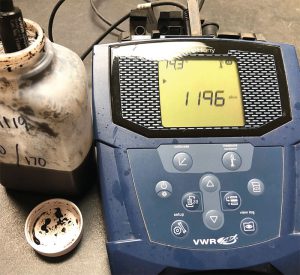
Electrical conductivity measures all soluble nutrients in compost using a meter like the one shown above. The analysis does not differentiate between salts that are beneficial to soil health, and those that have negative impacts. Photo courtesy of A&L Great Lakes Lab
Soluble salts are a more complicated and controversial topic of conversation in many soil and compost circles. Due to varying soil types and conditions nationwide, acceptable levels of electrical conductivity can vary and are widely debated. Soluble salts are typically reported with one of three equivalent units: mmhos/cm, mS/cm or dS/m. The method of measuring electrical conductivity of a certain material mixed with water at a given ratio can vary. Since compost is primarily a soil amendment and not a growth media or soil, the TMECC calls for a high level of dilution — 1:5 — in order to determine the electrical conductivity. Electrical conductivity measures all soluble nutrients in a given compost and does not differentiate between salts that are beneficial to soil health and those with negative impacts to soil health.
Soluble salts also can be reported as parts per million, which is then divided by 640 to achieve the standard mmhos/cm. One of the anonymous labs presented its result as parts per million, but failed to note that they converted it to mmhos/cm on the report. The average user may misinterpret that number or make faulty assumptions by interpreting the results as ppm rather than mmhos/cm. Because soluble salts are often a major limiting factor for compost application as a soil amendment, the higher the reported electrical conductivity, the lower the standard application rate of the compost.
The soluble salts analysis demonstrated the widest variation in reported results of all the parameters evaluated. For example, the same green waste compost sample produced test results ranging from 0.4 mmhos/cm to 8.20 mmhos/cm, differing by a factor of more than 20. With the biosolids compost samples, results ranged from 3.2 mmhos/cm to 19.50 mmhos/cm. These results illustrate how variations in material dilution can skew test results, pointing to the need for a standardized approach to soluble salts analysis in compost.
Our comparison showed that the more nutrient-rich biosolids compost had the biggest swings in electrical conductivity. As food waste composting grows, the resulting end product can also contain a high level of nutrients and potentially negative salts. The data seems to show that the higher the nutrient content, the wider the variation in potential results of electrical conductivity testing from different labs.
Organic Matter
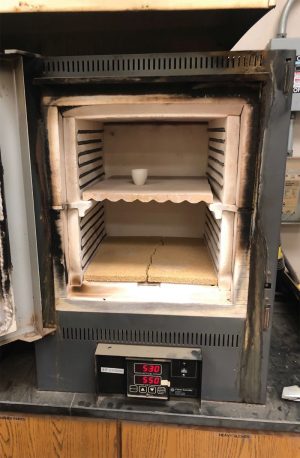
The commonly accepted practice to measure organic matter — known as “loss on ignition” — is to super heat a compost or soil in order to burn off the organic materials, which are carbon-based. Photo courtesy of A&L Great Lakes Lab
The last element analyzed in this project was organic matter. The Cornell University Department of Agriculture and Life Sciences defines organic matter as “the fraction of the soil that consists of plant or animal tissue in various stages of decomposition.” That fraction is made up of different components that can be grouped into three major types:
• Plant residues and living microbial biomass
• Active soil organic matter also referred to as detritus
• Stable soil organic matter, often referred to as humus
The organic matter provided by compost is often the most important and marketable feature. It provides much of what we consider the key factors of any given compost product’s physical, chemical and biological benefits that add to soil structure, health and plant success. The commonly accepted current practice to measure organic matter is to super heat a compost or soil in order to burn off the organic materials, which are carbon-based. This method is referred to as “loss on ignition.” The TMECC analysis is completed at 550°C and is considered an approximation because weight could be lost during combustion from other sources as well, e.g., plastic, or “mineral-bound” water. Results of organic matter analysis from the various labs were fairly consistent compared to the wide ranges seen in the soluble salts or pH results. The results from Lab #2 (Table 2) proved to be a wide outlier, likely due to using a lower temperature for its loss on ignition testing, or a shorter period of combustion time. Both affect the final approximation.
One item of note is that the non-TMECC labs showed higher internal variation of results for organic matter between the A and B split samples — up to as high as 8 percent between the split composite samples. By comparison, the TMECC lab reported much smaller differences between the split samples, limited to 0.5 percent variance or less. Internal lab controls and results are critical. Although sample composition may vary slightly, the TMECC lab and only one non-TMECC lab offered consistent results between the number 1 and 2 split samples.
Cornell Organic Matter Fact Sheet
Impacts On Reporting
The compost analyses conducted at a TMECC laboratory versus labs not participating in TMECC and CAP, illustrate differences in the reporting of important factors like organic matter, soluble salts and pH. These variations may make the use of compost more challenging or impossible in some situations. Dozens of states, thousands of architects, and many environmental agencies have adopted TMECC methods as the basis of design.
None of the data presented in the tables are meant as a criticism or warning about differing laboratories around the nation. We acknowledge that we cannot fully address the variation caused by failure to provide a truly similar representative of each compost sample. It is meant to present the reported differences that can arise from the same material being analyzed in varying ways. Without the TMECC, a universal compost language is not present in which to discuss and evaluate materials. The continued push for education and common standards is more important than ever as green infrastructure and other applications that rely heavily on compost are increasingly being implemented.
Charles Duprey is Founder and President of Naturcycle, LLC, which focuses on compost marketing and end use. The company sells compost throughout the Northeast, creating highest quality engineered soils like Green Roof Media exclusively using Seal of Testing Assurance “Certified” Compost.


